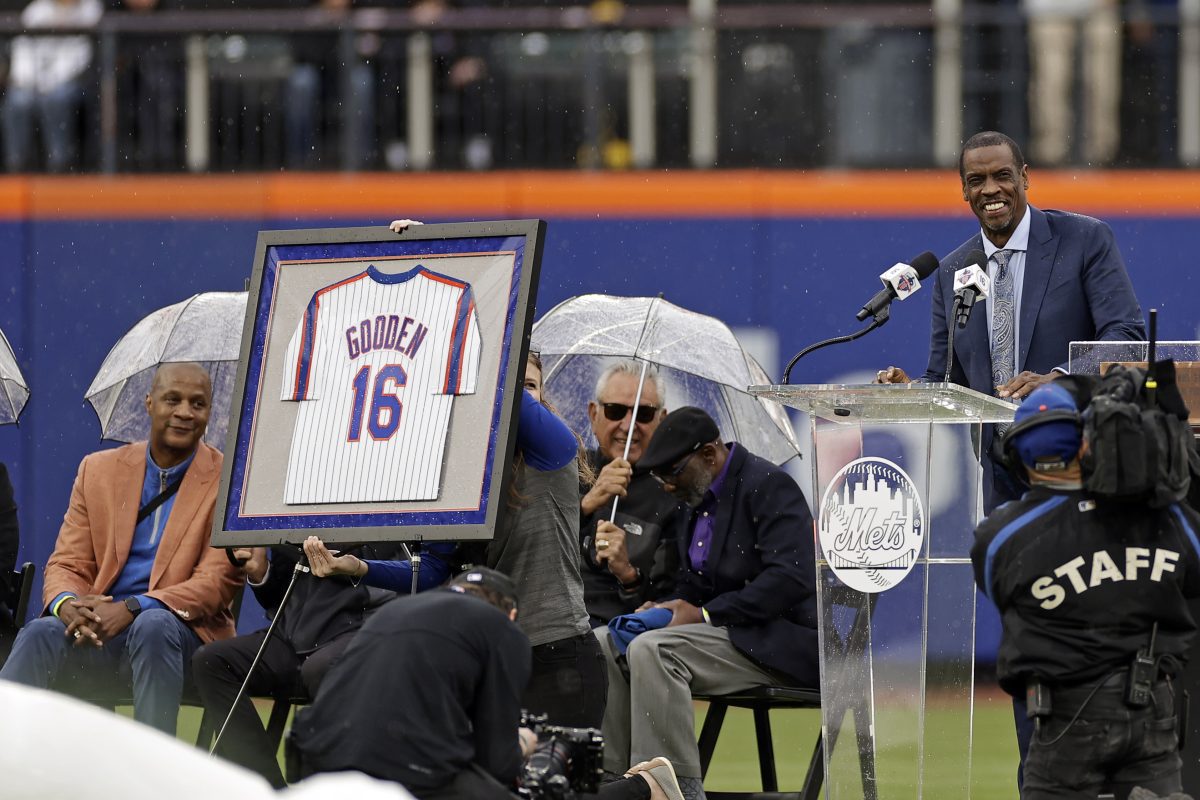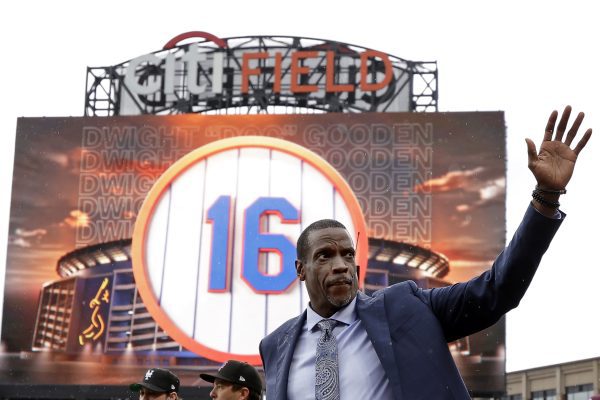



Dwight ‘Doc’ Gooden speaks during a pregame ceremony to retire his jersey number by the New York Mets before a game against the Kansas City Royals at Citi Field on April 14, 2024, in New York City. (Photo by Adam Hunger/Getty Images)
NEW YORK, N.Y. – The New York Mets retired the number of former right-handed pitcher Dwight Eugene “Doc” Gooden at Citi Field on Sunday afternoon.
Gooden joins No. 41 Tom Seaver, No. 31 Mike Piazza, No. 17 Keith Hernandez, No. 36 Jerry Koosman, No. 14 Gil Hodges, No. 37 Casey Stengal, and No. 24 Willie Mays as the only Mets players to have their numbers retired by the organization. Gooden was given a framed jersey and a bronzed pitching rubber listing all his accomplishments.
“It’s a great day to be a Mets Fan, and it’s a great day for Doc Gooden. Back then, nobody was as dominant as a pitcher as Doc was. I had the benefit of seeing him start 20 times between 1985 and 1986,” Keith Brown of Northport, N.Y., told World Baseball Network before the start of Gooden’s retirement ceremony. “The Mets fans started the “K Korner” because of Doc, and seeing him mow down one lineup after another was so incredible.”
Gooden threw the ceremonial first pitch to his grandson Kaden before the start of Sunday’s game after being driven around the warning track in the golf cart to greet the fans.
“It brings back a lot of memories from almost 30 years ago in Shea Stadium. It was just electrifying whenever Doc was pitching. It was a hopeful time with a really good team, and Doc was at the center of it all,” Mets fan Douglas Buffone of Huntington, N.Y., said to World Baseball Network before the pregame ceremony.
The 59-year-old ace was born in Tampa, Fla, on November 16, 1964. He made his Major League Baseball debut on April 7, 1984, at 19 and was named Rookie of The Year in his first season.
“Growing up as a kid in Tampa, you never think about having your number retired. You think about winning a World Series or playing in the major leagues, but you never think about having your number retired. So, for this to happen, I’m very humble, and I’m very blessed for this opportunity not only for myself but to share it with my kids, my grandkids, my teammates who helped make this possible, and all the fans who definitely made it possible”, Gooden said during his number retirement ceremony.
During his 16 seasons in the majors, Gooden played with the New York Mets from 1984-94, the New York Yankees from 1996-97 and 2000, the Cleveland Indians from 1998-99, the Houston Astros in 2000, and the Tampa Bay Devil Rays in 2000.
At the age of 17, Gooden was drafted out of Hillsboro High School in Tampa as the fifth overall pick in the 1982 MLB June Amateur Draft and signed on June 10, 1982, for a $85,000 contract and was assigned to Rookie Level Kingsport in the Appalachian League shortly after to play in his first professional season.
During Gooden’s 16 years in the bigs, he was a four-time All-Star from 1984-86 and 1988 and a two-time World Series champion with the Mets in 1986 and the Yankees in 2000. He also threw the 241st No-Hitter in MLB history with the Yankees on May 14, 1996, against the Seattle Mariners.

NEW YORK, NY – APRIL 14: Dwight “Doc” Gooden acknowledges the fans during a pregame ceremony to retire his jersey number by the New York Mets before a game against the Kansas City Royals at Citi Field on April 14, 2024 in New York City. (Photo by Adam Hunger/Getty Images)
Gooden won his only Cy Young Award in 1985 when he led the NL in strikeouts. He also led the league in strikeouts in his rookie year, finishing second in voting for the Cy Young Award in 1984.
He also won the Silver Slugger Award in 1992.
Gooden was the youngest player to appear in the 1984 All-Star Game at Candlestick Park in San Francisco at the age of 19 and struck out Detroit Tigers catcher Lance Parrish, Tigers center fielder Chet Lemon, and Seattle Mariners first baseman Alvin Davis during the bottom of the fifth inning.
His sweeping curveball earned him one of his nicknames, “Lord Charles,” in contrast with the phrase “Uncle Charlie” during the beginning of his career. It also affected his fastball, which topped at 98 mph and overpowered many hitters.
His off-field issues hampered his career. On December 13, 1986, Gooden was arrested in Tampa after being assaulted by a police officer. Then, in 1987, he tested positive for cocaine during spring training.
Gooden was sent to rehab on April 1, 1987, to avoid being suspended by the league’s commissioner’s office and did not make his first start until June 5. His drug problems didn’t stop then, however, and he was suspended for the 1995 season due to testing positive for cocaine for the second time.
“In 1994, unfortunately, the Mets wanted to cut ties, which I completely understood from a business standpoint, but I wanted to stay and make things right with you guys. I didn’t want to leave on the note that I did. Unfortunately they thought it was best that we go our separate ways,” Gooden said.
Gooden stated to the fans that he wanted to go back to the Mets three times after the 1997 and 1999 regular season and during the middle of the 2000 season. The Mets also denied him from signing a one-year contract with the organization before the start of the 2001 season after the Yankees cut him in spring training.
“Everything is about timing,” Gooden said. “Unfortunately, in 2019, I had a setback, and so now, today, the timing is right. My health is good. My mental health is good and today I get to retire as a Met and I want all you guys to know that you are a part of this and thank you so much.”
Gooden was also inducted into the Negro Leagues Baseball Museum’s “Hall of Game” on Sept. 9, 2023, in Kansas City, Mo., and joined former big league slingers Vida Blue, Al Downing, Mike Norris, and Dontrelle Willis.
Gooden finished his 16 seasons with a 194-112 record, a 3.51 ERA with 410 starts and 430 appearances with 68 complete games, 24 shutouts, recording three saves, throwing 2,800 innings, allowing 2,564 hits, 1,091 earned runs, 210 home runs, 954 walks, 2,293 strikeouts, while facing 11,705 batters and posting a 1.256 WHIP.
Gooden is 58th on the all-time strikeout list.